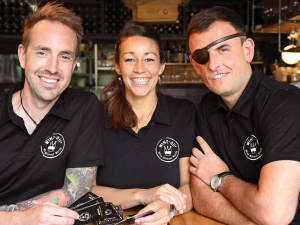That's from Maciej Zimny, owner-Director of Noble Rot Wine Bar, and now Chief Wine-olojist at the newly launched Wine-oji Services. To address this perceived failing, he and fellow Noble Rot sommeliers Josh Pointon and Jessica Wood have developed Wine-oji, an emoji-style visual wine tasting language.
Based on the trio's experience selling wine, the system seeks to describe "wine without words" using emoji graphics to convey different elements of a wine. These incorporate the structural components of sweetness, acidity, body, oak and finish, rated from 0 to 5, a wide range of aroma/flavour characters and food matches. Mouthfeel characters are not explicitly included, given Maciej reports little interest in these from this customers, or the younger generation of drinkers. The system is envisaged as being both a training tool, and an accessible way for wine producers to communicate about their wines to consumers and the trade.
"The main challenge in communicating wine attributes using words is the complexity of the language used to express what's in the bottle," says Maciej. He considers the language used by wine reviewers is often too personal or vague to be meaningful for consumers, while formal tasting notes are too complex for new wine drinkers to understand. He also notes the "lack of scalability" of written descriptions, when conveying characters such as acidity.
Visual wine descriptions have a number of advantages over written ones, Maciej notes: "A visual application transcends spoken language and can therefore be understood in any country. It presents exactly what's in the bottle in a modern, visual way and, by breaking down its stuffy reputation, simplifies a beverage which is notoriously complex yet widely consumed. A visual profile also saves time in identifying wine's individual components; for example, levels of acid or oak, or whether the wine is vegan." He suggests that the ability for consumers to make clear visual comparisons between wine profiles might encourage experimentation with a wider range of similar varieties, while the number of Wine-Ojis used presents an easy indication of wine complexity. "And of course, for many people images are much more memorable than words."
As an educational tool, Wine-oji has created visual profiles of Classic Wine Styles of New Zealand and The World, to "gamify learning about regional wine flavour profiles". The modern wine language of Wine-oji can be used for staff training, cellar door activities "or while sitting at home sipping wine", Maciej explains. "Because the profile presents exactly what's in the bottle, everyone can learn to pick individual characteristics and learn about a wine's structure, making it a very accessible tool for wine novices and experts alike."
"Wine producers are able to provide a visual representation of their wine across their digital marketing platforms and website for selling wine online," Maciej adds. "At the cellar door, point of sales are enhanced through using printed Wine-oji material for staff training and customer tasting. The Wine-oji profile helps wine drinkers identify individual aromas or flavours without the pressure of guessing the wine's characteristics incorrectly, making the whole process more engaging and fun."










